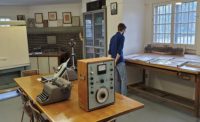Achieving New LEED v4.1 Acoustic Credits
Walls and ceilings are the critical building components in determining LEED credit(s) achievement.


Simply put, most LEED v4.1 noise and isolation acoustic goals are easily achievable using standard construction methods by keeping the noisy things away from the quiet spaces.

All disciplines cut, fasten, patch and otherwise modify the walls and ceiling assemblies in a project.

If a wall or ceiling in the project is not built exactly like the lab tested assembly, then the sound rating is not valid.

Each discipline must provide separate details for their penetrations, construction gaps and connections at sound rated walls and ceilings.





The just-released, version 4.1 of the U.S. Green Building Council’s (USGBC) Building Design and Construction guidelines makes achieving those LEED credits much more practical and rewarding. For example, in response to practical feedback from the construction industry, acoustic goals in the new version of the guidelines have been set to more realistic levels. As an added incentive, each space in most projects now only has to achieve two out of three of its acoustic goals for the entire project to achieve LEED acoustic credit. A bonus credit is awarded to those projects whose spaces meet all three acoustic goals.
In every LEED project I’ve worked on so far, the critical building components in determining whether the project achieved LEED credit(s) for acoustics has been its walls and ceilings. LEED v4.1 now makes achieving those goals low-hanging fruit for those counting up available LEED credits on their project. Complicated wall and ceiling designs and exotic materials aren’t necessary; but early team coordination and attention to detail is.
What is LEED?
LEED, the Leadership in Energy and Environmental Design, is a “green building” certification program created by the non-profit organization USGBC (U.S. Green Building Council) to promote building practices which their membership have determined are sustainable and to discourage those they have determined to be non-sustainable. Initially released in 2000, this year’s release is the sixth revision.
USGBC’s stated mission is “to transform the way buildings and communities are designed, built and operated, enabling an environmentally and socially responsible, healthy, and prosperous environment that improves the quality of life.” They intend to accomplish this by having their rating system adopted within building project specifications. Depending on project type, location, and certification level, LEED certified projects may be eligible for substantial federal, state, local government and school district initiatives and tax incentives.
Projects earn credits in design, construction planning and building commissioning performance measured relative to LEED sustainability standards. Credits are tracked on the project’s scorecard and summed to determine the level of certification. Projects with at least 40 credits are LEED Certified, 50 credits earns LEED Silver, 60 credits earns LEED Gold and 80 credits achieves LEED Platinum.
LEED Acoustic Requirements
The LEED guidelines divide acoustic goals into three categories:
- Maximum background noise produced by heating, ventilating and air conditioning (HVAC) systems
- Minimum isolation from adjacent spaces
- Adequate amount and type of sound absorbing finishes
Specific LEED acoustic goals for each of the three categories is dependent on the type and layout of the project.
While the acoustic goals for most project types are optional, all LEED school projects must achieve published minimum standard acoustic goals. Only then can a school project proceed to earn one acoustic credit for achieving elevated acoustic goal levels.
LEED Healthcare projects earn one acoustic credit for meeting both the HVAC background noise, and the isolation acoustic goals. They earn a second acoustic credit for meeting the sound absorbing finishes goal and for limiting the outside noise the project generates.
Two out of Three Ain’t Bad
All other LEED project types (New Construction, Data Centers, Warehouses & Distribution Centers, Hospitality) get a big break in the version 4.1 guidelines. Each space in the project now only has to achieve two out of three of its acoustic goals for the project to achieve one LEED acoustic credit. This is an especially helpful approach when you realize that not all spaces need to meet the same two acoustic goal categories. This allows the design team to choose the most cost-effective pair of acoustic goals for each space to help control project cost and acoustic performance. Projects whose spaces meet all three acoustic goals earn a bonus credit.
Making the Acoustic Grade
Looking through the 110 LEED credits available for a project to pursue, it becomes immediately obvious that there are much easier ways to earn one or two credits. Consequently, earning one or two measly acoustic credits is typically not given a high priority in most LEED driven projects, except maybe late in the project design when scrambling for credits to convert the project to the next highest LEED rating. Unfortunately, a big part of achieving acoustic credits relies on coordination of the design among disciplines—not expensive, but something that can’t be achieved late in the game.
The biggest opportunity for using coordination of the design to address noise and isolation goals occurs at the beginning of the design, when decisions are being made on project site selection, building orientation and space programming. Simply put, most LEED v4.1 noise and isolation acoustic goals are easily achievable using standard construction methods by keeping the noisy things away from the quiet spaces. High performing demising wall and ceiling designs are available, although, all of them are non-standard, expensive and difficult to construct and coordinate correctly. At this early stage, decision-makers would be wise to consult with acoustic consultants and general contractors to estimate the added construction costs and risks before making a final decision to locate an auditorium, for example, next to a mechanical room.
Once the project has been programmed (rooms arranged and their functions defined), it is a simple but time-consuming matter to estimate how much noise is generated within each room and how much of that noise bleeds into the adjacent spaces. The need, location and minimum rating for sound rated walls and ceilings is determined by comparing the calculated noise levels to the acoustic goals of each room. The result is a list of sound rated demising walls in the project and their minimum required STC ratings to meet LEED goals. A list of sound rated ceilings in the project will generally list minimum required STC and IIC ratings to meet LEED goals.
Working from the list of minimum required STC and IIC ratings, the project architect will typically choose three or four sound-rated wall and ceiling designs from a catalog of published designs. Depending on the range of sound ratings and number of wall types in the project, the architect may be able to cover the project requirements with sound-rated assemblies of STC40, STC45 and STC50, for example.
A very common mistake at this stage is not coordinating the details required to duplicate the sound tested assembly with what will eventually be built by the contractor. For example, project specifications may allow stud gauge and spacing to be selected by the contractor according to whether the wall is load bearing or not. Without coordination, the resulting STC rating is anyone’s guess. To be blunt, if a wall or ceiling in the project is not built exactly like the lab tested assembly, then the sound rating is not valid. Stud gauge, stud spacing, type and thickness of wall boards, insulation type, and even screw spacing and pattern, all have effects on the STC rating of a wall. Variations in any of these can drop the STC value by 10 points or more—and worst of all, the severity of the change in STC can’t be predicted using common sense logic; it has to be lab tested or estimated by a very-experienced acoustic consultant.
Complicating the selection of wall types to match lab tested STC rated assemblies is the need for projects to also match UL fire ratings where needed. A common mistake when selecting UL rated assemblies is to assume the reference STC rating listed on the UL assembly applies for any assembly which matches the UL assembly. Each UL fire-rated assembly typically includes construction options with large variations in stud gauge, stud spacing, type, number and thickness of wall boards, insulation type and fastening systems—all of which result in a large and unpredictable variation in STC value as previously described.
Another common mistake is selecting an STC rated assembly based solely on low material costs without regard to the costs of coordinating the design and construction. For example, one very popular STC rated assembly component is the resilient channel (RC). High STC values for wall and ceiling assemblies using RC are achieved because the gyp board is not rigidly attached to the studs or joists of the assembly. Instead, the gyp board hangs on the RC channel and is free to move with sound pressure, draining sound energy in the process. This works very well if coordinated throughout the design and construction. More often than not, the requirement for the gyp board to move freely in RC assemblies is not coordinated in the project, a rigid connection is made into the board, and the STC rating of the assembly plummets below hoped-for levels. Installation of wall cabinets, mud and tape finishing of periphery joints, electrical boxes, lighting, plumbing and duct penetrations are all common sources of rigid attachments which will negate STC values of RC assemblies.
Too Many Cooks Spoil the Pot
Plumbers plumb, electrical and technology contractors pull wire, mechanical contractors run ducts, finish carpenters mount cabinets and trim, etc. and they all cut, fasten, patch and otherwise modify the walls and ceiling assemblies in a project. By far, the most common mistake, and the most cost effective one to avoid, is not coordinating joints, penetrations, attachments and other necessary modifications of sound rated walls by the various disciplines. Although each discipline typically includes fire and smoke penetration details in their construction drawings and specifications, these are generally not adequate or applicable for the project’s sound rated walls and ceilings. The architect needs to inform each discipline of the requirements for interfacing with sound rated walls and each discipline must respond by providing separate details for their penetrations, construction gaps and connections at sound rated walls. Any use of the phrase “rated assembly” needs to be reviewed.
Coordination to a Higher Level
Team coordination and attention to detail allows the sound rated walls and ceilings of a project to easily meet the new LEED v4.1 acoustic goals. Although the level of team coordination needed to meet the acoustic goals of a project is higher than most, and the LEED acoustic credits are only one or two, it’s difficult to imagine any project team displaying that requisite level of coordination not being able to earn any credits they set their sights on. W&C
Looking for a reprint of this article?
From high-res PDFs to custom plaques, order your copy today!













